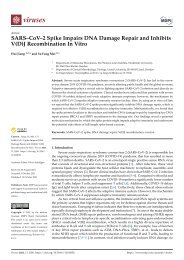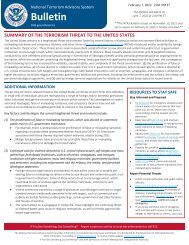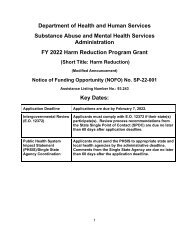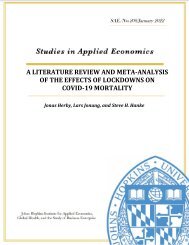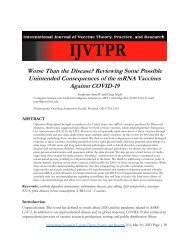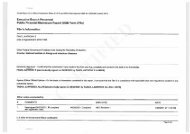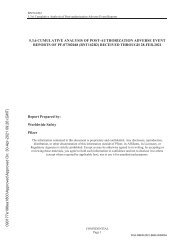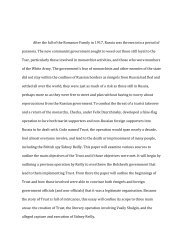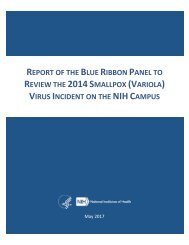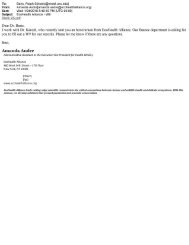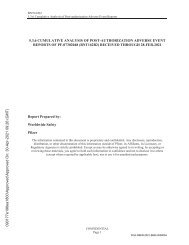MSH3 Homology and Potential Recombination Link to SARS-CoV-2 Furin Cleavage Site
Create successful ePaper yourself
Turn your PDF publications into a flip-book with our unique Google optimized e-Paper software.
Ambati et al.<br />
<strong>MSH3</strong> <strong>and</strong> <strong>SARS</strong>-<strong>CoV</strong>-2 Spike <strong>Homology</strong><br />
AcquisitionofthereversecomplementFCSsequencefroman<br />
overexpressed positive sense <strong>MSH3</strong> mRNA could occur through<br />
copy choice recombination with a negative sense <strong>SARS</strong>-<strong>CoV</strong>-2<br />
RNA intermediate (15), involving jumping from one template<br />
<strong>to</strong> another (19) (Figure1). The homology between <strong>SARS</strong>-<strong>CoV</strong>-<br />
2 <strong>and</strong> other known coronaviruses is discontinued <strong>and</strong> most<br />
<strong>SARS</strong>-<strong>CoV</strong>-2 sequences derive from a relatively recent common<br />
ances<strong>to</strong>rwithbatRaTG13.Moreover,similarityplots(SimPlots)<br />
have identified sudden changes in sequence identity between<br />
<strong>SARS</strong>-<strong>CoV</strong>-2 <strong>and</strong> RaTG13, signaling potential recombination<br />
events, which could explain the capability of <strong>SARS</strong>-<strong>CoV</strong>-2<br />
binding <strong>to</strong> ACE2 through its RBD, which is not the case for the<br />
RaTG13RBD(15).<br />
A criticism of this hypothesis is that the identified sequence<br />
is on the opposite str<strong>and</strong> of the open reading frame in SEQ<br />
ID11652. However, cells transfected with <strong>MSH3</strong>, which induce<br />
mismatch repair deficiency could have targeted double-str<strong>and</strong>ed<br />
cDNA encoding SEQ ID11652. Such cells co-transfected with<br />
a <strong>SARS</strong>-like virus expressing RdRp could attach <strong>to</strong> this 19-<br />
nucleotide sequence (15) <strong>and</strong> permit integration of a fragment<br />
from the negative str<strong>and</strong> in<strong>to</strong> the viral genome, including the<br />
FCS, despite being on the opposite str<strong>and</strong> of the open reading<br />
frame.Mismatchrepairmechanismshaveenabledintegrationof<br />
short fragments from antisense str<strong>and</strong>s in experimental models<br />
(20, 21). Microhomology can direct recombination between the<br />
<strong>MSH3</strong> <strong>and</strong> a <strong>SARS</strong>-like virus, which could take place at the<br />
19-nucleotidesequenceofinterest.<br />
The presence in <strong>SARS</strong>-<strong>CoV</strong>-2 of a 19-nucleotide RNA<br />
sequence encoding an FCS at amino acid 681 of its spike<br />
protein with 100% identity <strong>to</strong> the reverse complement of<br />
a proprietary <strong>MSH3</strong> mRNA sequence is highly unusual.<br />
<strong>Potential</strong> explanations for this correlation should be<br />
furtherinvestigated.<br />
DATA AVAILABILITY STATEMENT<br />
Publicly available datasets were analyzed in this study. This data<br />
canbefoundhere:SEQID11652.<br />
AUTHOR CONTRIBUTIONS<br />
Theinvestigation<strong>and</strong>originaldraftwereinitiatedbyBA,AV,<strong>and</strong><br />
AB. The visualization was performed by BA, AV, AB, <strong>and</strong> GP.<br />
The writing <strong>and</strong> editing were done by BA, AV, KL, GP, BU, VU,<br />
<strong>and</strong> AB. All authors contributed <strong>to</strong> the article <strong>and</strong> approved the<br />
submittedversion.<br />
ACKNOWLEDGMENTS<br />
WearethankfulforthecontributionofDr.JianYing,University<br />
ofUtah,Eureka,USA<strong>to</strong>theprobabilityanalysis.<br />
SUPPLEMENTARY MATERIAL<br />
The Supplementary Material for this article can be found<br />
online at: https://www.frontiersin.org/articles/10.3389/fviro.<br />
2022.834808/full#supplementary-material<br />
REFERENCES<br />
1. Garushyants SK, Rogozin IB, Koonin EV. Template switching <strong>and</strong><br />
duplications in <strong>SARS</strong>-<strong>CoV</strong>-2 genomes give rise <strong>to</strong> insertion variants that<br />
merit moni<strong>to</strong>ring. Commun Biol. (2021) 4:1343. doi: 10.1038/s42003-021-<br />
02858-9<br />
2. WuF, ZhaoS,Yu B,Chen, YM, WangW, SongZG,etal. Anewcoronavirus<br />
associated with human respira<strong>to</strong>ry disease in China. Nature. (2020) 579:265–<br />
9.doi:10.1038/s41586-020-2008-3<br />
3. Coutard B, Valle C, de Lamballerie X, Canard B, Seidah NG,<br />
Decroly E. The spike glycoprotein of the new coronavirus 2019-<br />
n<strong>CoV</strong> contains a furin-like cleavage site absent in <strong>CoV</strong> of the same<br />
clade. Antiviral Res. (2020) 176:104742. doi: 10.1016/j.antiviral.2020.<br />
104742<br />
4. Walls AC, Park YJ, Tor<strong>to</strong>rici MA, Wall A, McGuire AT, Veesler<br />
D. Structure, Function, <strong>and</strong> Antigenicity of the <strong>SARS</strong>-<strong>CoV</strong>-2 Spike<br />
Glycoprotein. Cell. (2020) 181:281–92.e286. doi: 10.1016/j.cell.2020.<br />
02.058<br />
5. Lau SY, Wang P, Mok BWY, Zhang AJ, Chu H, Lee ACY, et al. Attenuated<br />
<strong>SARS</strong>-<strong>CoV</strong>-2 variants with deletions at the S1/S2 junction. Emerg Microbes<br />
Infect.(2020)9:837–42.doi:10.1080/22221751.2020.1756700<br />
6. PeacockTP,GoldhillDH,ZhouJ,BaillonL,FriseR,SwannOC,etal.Thefurin<br />
cleavage site in the <strong>SARS</strong>-<strong>CoV</strong>-2 spike protein is required for transmission<br />
in ferrets. Nat Microbiol. (2020) 6:899–909. doi: 10.1038/s41564-021-<br />
00908-w<br />
7. Xia S, Lan Q, Su S, Wang X, Xu W, Liu Z, et al. The role of furin<br />
cleavage site in <strong>SARS</strong>-<strong>CoV</strong>-2 spike protein-mediated membrane fusion in<br />
the presence or absence of trypsin. Signal Transd. Targeted Ther. (2020)<br />
5:92.doi:10.1038/s41392-020-0184-0<br />
8. Hou W. Characterization of codon usage pattern in <strong>SARS</strong>-<strong>CoV</strong>-2. Virology J.<br />
(2020)17:138.doi:10.1186/s12985-020-01395-x<br />
9. K<strong>and</strong>eelM,IbrahimA,FayezM,Al-NazawiM.From<strong>SARS</strong><strong>and</strong>MERS<strong>CoV</strong>s<br />
<strong>to</strong> <strong>SARS</strong>-<strong>CoV</strong>-2: Moving <strong>to</strong>ward more biased codon usage in viral structural<br />
<strong>and</strong>nonstructuralgenes.JMedVirol.(2020)92:660–6.doi:10.1002/jmv.25754<br />
10. BancelS,ChakrabortyT,DeFougerollesA,ElbashirSM,JohnM,RoyA,etal.<br />
Modified Polynucleotides for the Production of Oncology-Related Proteins <strong>and</strong><br />
Peptides.Cambridge,MA:UnitedStatesPatent.(2016).<br />
11. MacRae SL, McKnight Croken M, Calder RB, Aliper A, Milholl<strong>and</strong> B, White<br />
RR, et al. DNA repair in species with extreme lifespan differences. Aging.<br />
(2015)7:1171–84.doi:10.18632/aging.100866<br />
12. Mauro VP, Chappell SA. A critical analysis of codon optimization<br />
in human therapeutics. Trends Mol Med. (2014) 20:604–<br />
13.doi:10.1016/j.molmed.2014.09.003<br />
13. Marra G, Iaccarino I, Lettieri T, Roscilli G, Delmastro P, <strong>and</strong> Jiricny J.<br />
Mismatch repair deficiency associated with overexpression of the <strong>MSH3</strong><br />
gene. Proc Natl Acad Sci USA. (1998) 95:8568. doi: 10.1073/pnas.95.15.<br />
8568<br />
14. Chambers BS, Hea<strong>to</strong>n BE, Rausch K, Dumm RE, Hamil<strong>to</strong>n JR, Cherry S,<br />
et al. DNA mismatch repair is required for the host innate response <strong>and</strong><br />
controls cellular fate after influenza virus infection. Nat Microbiol. (2019)<br />
4:1964–77.doi:10.1038/s41564-019-0509-3<br />
15. Gallaher WR. A palindromic RNA sequence as a common<br />
breakpoint contribu<strong>to</strong>r <strong>to</strong> copy-choice recombination in <strong>SARS</strong>-<br />
COV-2. Arch Virol. (2020) 165:2341–8. doi: 10.1007/s00705-020-<br />
04750-z<br />
16. Haque F, Lillie P, Haque F, Maraveyas A. Deficient DNA mismatch<br />
repair <strong>and</strong> persistence of <strong>SARS</strong>-<strong>CoV</strong>-2 RNA shedding: a case report<br />
of Hereditary Nonpolyposis Colorectal Cancer with COVID-19<br />
Frontiers in Virology | www.frontiersin.org 4 February 2022 | Volume 2 | Article 834808




